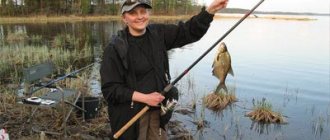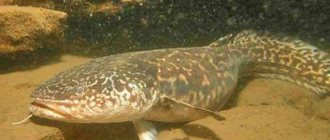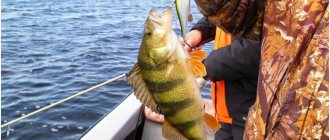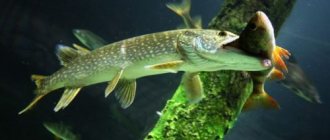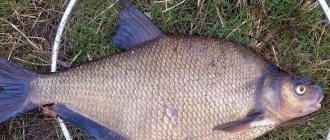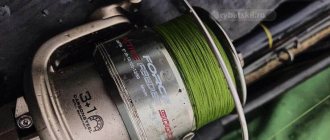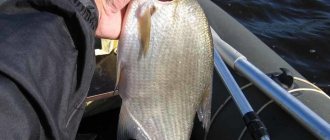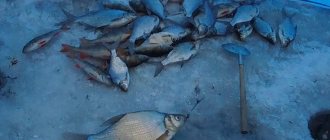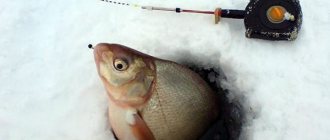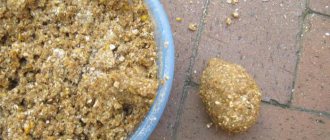Catching bream in April on a feeder
The long-awaited time of ice melting and warming opens up new horizons for fishermen. So, fishing for bream in April on a feeder is very effective, because all the fish are moving away from winter torpor and active fish biting begins in preparation for the upcoming spawning.
Bream is a bottom-dwelling fish that feeds mainly on larvae, that is, most of its food is of animal origin. With a good food supply, bream grows quickly. Found in most rivers, such as the Don and Volga; in lakes, artificial ponds with running water (Tsimlyansk Reservoir). It feeds at dawn and at night in the shallows, near the shore.
What fish can you catch in April on rivers, lakes and ponds?
At the beginning of a fishing trip in April, it is worth refreshing your knowledge about the species of fish that become very active at this time. At this time, roach, rudd and bream are doing well, crucian carp and carp are waking up after hibernation, and predators such as pike perch and pike are quite active. Burbot also shows sufficient activity, storing up nutrients before entering summer hibernation. Somas show some activity. This is facilitated by the water temperature, which usually does not fall below 5 degrees Celsius, and in the southern regions of our country it already reaches 14 - 17 degrees. Accordingly, as the water temperature rises, the fish begin to understand that the spawning period is approaching. And this indicates the need to stock up on nutrients.
The best way to catch roach is with a float, which should not be too heavy. You can fish from the shore, but this is more suitable for catching larger specimens. It is also worth examining the air pressure - it should not fall below 990 hPa and be above 1009 hPa. It is also necessary to mention the bait. In spring, in April, white and red worms are often used. Lures of plant origin are not completely denied. You can use corn or peas as bait.
On the other hand, bream in April is just preparing for spawning, but it does so quite dynamically. This is a sign that this species is worth focusing on. Fish of this species can be found at a depth of 10 - 15 meters, but in April it is best to take them in shallow water, where the depth is no more than 3 meters. In rivers, this type of fish chooses places with the calmest flow possible, in which there is a lot of last year’s vegetation. Very often, bream can be found in thickets of last year’s reeds. You may also find them in bays or corners. Fishing methods are similar to roach fishing, meaning the float works great and the ground is acceptable. It is worth baiting a hook with a white bream with a red or white worm; maggot is popular at this time, and the bream simply cannot refuse the so-called sandwich. Carp baits are also often used.
In April we can also meet tench. There are persistent rumors that fishing for tench is more suitable for the month of May, but many experienced fishermen manage to catch it already in April. Tench, like roach and bream, as well as other types of white fish, begins to actively feed when the water temperature rises. It is best to fish using bottom gear or the float method. But still, the feeder undeniably comes first here. Tench prefer carp scents. So the worms work first.
Carp may also show up from time to time at the April meetings. The problem, however, is finding them. They can move very quickly and give no visible signs. At this time of year they often live in smaller and shallower aquariums. Too much bait in early spring will not be attractive to them due to their slightly slower metabolism. Important information is also the color of the leader - it should look natural, that is, its color should resemble the color of the brown bottom. On the hook we can put protein balls, which are often combined with corn.
And of course, we cannot fail to mention predatory fish species such as pike perch and pike. At this time of year, you should look for them in shallow water not far from last year’s thickets of grass or reeds. This is directly related to the feeding areas of the awakened white fish, which is preparing for spawning and is looking for provisions in these places. At this time, pike perch are caught mainly with spinning rods; minnow wobblers, silicone baits or any other actively playing medium-sized bait are often used as bait. If you choose pike as your target, then you should also use medium-sized baits, according to the advice of experienced spinning anglers
Where to catch bream on a feeder in April
His favorite places are silted, clay bottom, deep parts of the reservoir. It is easy to find by observing the surface of the river a little in calm weather. The flock can be seen playing. So, you can start fishing. The easiest way to catch it is to fish at night, close to where the fish live. Usually it does not travel long distances from its permanent location.
If you have a steep yar in mind, next to which there is a calm current and quite deep, as well as a flooded tree, you need to try it. An exit from holes, a deep fairway, next to a dam or dams, a little trash - all this attracts him.
Where to look for bream in April
Most often, the location relative to the shore depends on the weather. The cooler it is, the farther from the coast it moves.
Often during the day it can be seen in the shallows far from the shore, because the water in such places warms up better.
At night, on the contrary, the water cools down more slowly in the depressions, so the bream rolls up and stands there.
Morning bream fishing on a feeder in April can be the most successful. On a sunny morning it approaches the shore and is at a depth of about one and a half or two meters. After which, as the water warms up, it moves back to the shallows.
In the evening it approaches coastal areas covered with algae.
Where to look for roach
The first food appears in sufficiently warmed areas of the reservoir, therefore, fish must be looked for at shallow depths. Knowing the caution of this fish, it is reasonable to assume that it will stay close to the shallows at a depth of 1.2-2 meters.
During the zhora, roach moves closer to the spawning grounds; it spawns at the mouths of tributaries and near small streams. It’s easy to guess that in the morning, the fish will be downstream from these places, and when the water warms up, they will rush there.
The peculiarity of the roach is that when the water gradually warms up during the day, it rises to the spawning grounds, and if the temperature does not suit it, it rolls back. This can continue day after day until the water reaches the desired temperature.
Knowing this, if the weather is stable, you can come every day at the same time and in the same place, and always be with a catch. For example, I like to go in the late afternoon, when the fish are as close as possible to the mouth of the tributary. This way you can stand higher and fish in the retrieve.
Also, do not forget that roach likes to stand in the water floor, and the fishing horizon must be appropriate. The exception is fishing with bottom gear, for example when fishing with a feeder.
Spring bream fishing on a feeder in April
If you want to catch a large specimen of bream, then you need to be patient and properly prepare the tackle and installation of equipment. The time for fishing is day or late evening. You won't need a rigid rod. The length of the feeder blank - 3-4 meters will be sufficient, because at this time it comes closer to the shore.
Feeder gear for catching bream in April:
- The length of the rod must be at least 3.6 m with a test weight of up to 90 g. When fishing on a river, you can take a longer rod.
- It is preferable to use a reel in the range from 3000 to 4000. It will also not be amiss, especially when fishing at night, to use reels with a baitrunner.
- The choice of fishing line depends on the recommendations on the rod itself. Moreover, the diameter of the leash must be at least 0.12 mm. Monofilament can be used as the main thread in still water, or braided thread for currents.
- The size, weight and shape of the feeder is determined by the fishing location. For a standing pond, round, oval, rectangular models made of metal or plastic weighing 40-60 g are suitable. To fish in the current, rectangular or triangular shaped metal feeders weighing 60-100 g are required.
- The length of the leash is not so important; sometimes it can reach 1 meter with a weak bite. But you should start with a leash 30-50 cm long.
- The choice of hook directly depends on the bait used, as well as the size of the trophy. For bream, the optimal size would be No. 8-14.
- Of the great variety of feeder equipment, the asymmetrical loop and paternoster have proven themselves the best.
The most effective tackle for catching bream during this period, undoubtedly, remains a feeder. The feeder allows you to cast to the required distance and place a portion of bait close to the hook with bait, which in itself is an attractive factor. When choosing a feeder, it is very important to pay attention to the fact that after lowering to the bottom, it lies motionless and does not succumb to displacement under the flow of water, otherwise its “dance” will scare away the wary bream.
Often, fishermen, trying to get rid of the “dancing” of the feeder, make various modifications: this is an increase in the weight of the feeder by mounting “Cheburashkas” in its basket, which are used in spinning fishing; equipment on the sides of the feeder - wire mustaches or arcs with which the feeder will cling to the ground, etc. Although in fairness, I note that nowadays it is not so difficult to choose a feeder feeder of the required weight and shape (with a rectangular, triangular or teardrop-shaped cross-section) in a fishing store. Paying attention to the shape, remember that the most stable feeders are those in which the lead is mounted on the entire plane of the “sole”, and not in a narrow strip in its center. In addition, feeder feeders, in which the width of the “sole” is greater than the height itself, are the most resistant to tipping over.
Speaking about the equipment itself, it’s a matter of taste – a “paternoster”, a symmetrical loop or a “helicopter”. The only limitation can be the use of an anti-twist tube, as it can tremble, echoing the fluctuations of the water masses. But again, this is my opinion and I will not deny that I have seen quite effective bream fishing with such equipment. I myself fish with an asymmetrical loop and confidently consider such equipment to be the “only suitable” one for this matter.
Leashes for catching bream should be long, from 0.7 to 1 meter. Having straightened out in the current, he will remove the hook with bait from the rig, and thus all its movements when carefully tightening the line at the moment of biting will be hidden from the eyes of the bream, which gives the fisherman a head start in time for a successful and timely hook.
The most “tasty” bait for bream will be a worm, maggot, or bloodworm because they contain a large amount of protein, which the fish needs in the spring. It’s a good idea to experiment with “sandwiches”, combining both plant and animal components for the bait.
It would not be fair to ignore the topic of bait, since without it, catching bream would be more an accident than a pattern. It is necessary to feed the bream, but remember that in the spring the fish do not need a lot of food. Remember also that the bait should be localized as much as possible at the bottom, and have increased inertness and viscosity.
Don’t try to base your fishing tactics solely on the fact that bream will come to the bait you provide. You need to start from knowledge of the reservoir, its bottom characteristics and feeding places for schools of bream. If your knowledge in this area is not significant, then at least try to find evidence that bream actually feeds in one place or another. Visual signs of the presence of bream may be: clouds of turbidity rising from the bottom; pop-up air bubbles; slight disturbances of water on the surface from the passage of fish.
And finally, about the composition of the bait itself. An undoubted “hit” will be “Salapinka” (the name of this composition comes from its developer Dmitry Salapin) - cooked pearl barley and wheat porridge with sunflower oil and a bag of vanilla sugar, and then mixed together with the usual base mixture. I’ll warn you right away that this mixture became a “hit” not so much because of its outstanding qualities, but rather because of the ease of preparation, budget and availability of the constituent components.
As an alternative to “Salapinka,” I will offer the reader another composition that is no less effective and suitable for catching bream throughout the warm season, and which I have been using myself for many years. The composition of the bait includes: breadcrumbs (3 parts); shortbread cookies (1 part); wheat bran (1 part); ground corn, boiled (1 part); oatmeal or oatmeal (0.3 parts); roasted and crushed sunflower seeds (1 part). To form turbidity - a bag of powdered milk, if there is none - 2-3 tbsp. spoons of regular condensed milk per glass of non-chlorinated water. In addition, you can add bloodworms, chopped worms or maggots to the bait.
Video
Fishing for bream in April with Normund video
On the river, spring feeder fishing in April with Normunds Grabovskis in Estonia on the Emma River.
Catching bream on a feeder in spring video
Catching bream on a feeder in the spring is very interesting and exciting. Fishing in general in the spring is difficult in itself; you need to find the key to the fish and not make mistakes in the bait. Fishing in the spring of the 2106 season, video report on catching bream on the feeder. Catching bream on a feeder was our goal for this spring fishing on the Neva River. The morning fog did not give us the opportunity to properly feed the point with bait to attract bream, but despite this, the bream was biting perfectly in the earliest spring morning. And what could be better than fishing in the spring and the long-awaited bites on the feeder. Only by lunchtime the bite subsided, when the sun rose high and warmed the air. This was the second spring fishing trip this season. And I was very pleased with her!
Bream fishing tips
Every angler planning to catch April, and not only April bream, should know all these nuances discussed in this article. And it’s not easy to know, but also to take into account. If he does not take this into account and generally tries not to pay attention to all this, then bream fishing will never be successful. In the middle of summer you can go fishing and accidentally catch a bream, and also catch it by chance. In April, such accidents do not happen; spring bream does not forgive accidents. Actually, even in the summer it may not always be like this, maybe once a year. Therefore, remember, you need to approach bream fishing with complete seriousness, otherwise you will not catch this fish.
Now you know everything about catching April bream, so all that remains is to wish you good luck and the most successful bite. April is already ending, so don't miss the last opportunity.
